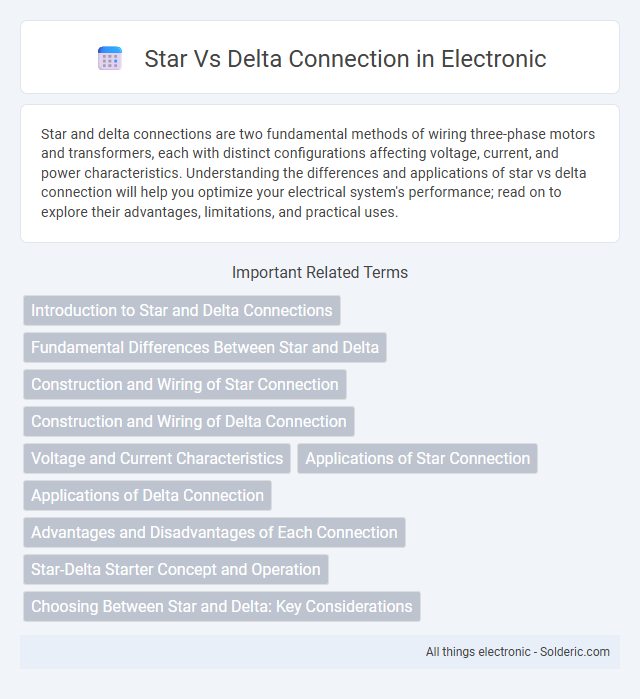Star and delta connections are two fundamental methods of wiring three-phase motors and transformers, each with distinct configurations affecting voltage, current, and power characteristics. Understanding the differences and applications of star vs delta connection will help you optimize your electrical system's performance; read on to explore their advantages, limitations, and practical uses.
Comparison Table
| Feature | Star Connection (Y) | Delta Connection (D) |
|---|---|---|
| Phase Voltage | Line Voltage / 3 | Equal to Line Voltage |
| Phase Current | Equal to Line Current | Line Current / 3 |
| Neutral Point | Available | Not Available |
| Power Factor Correction | Easier due to neutral | More complex |
| Starting Torque | Lower | Higher |
| Application | Long distance power transmission, light loads | High power industrial motors, heavy loads |
| Fault Tolerance | Better for open phase faults | Less tolerant to open phase faults |
| Efficiency | Lower | Higher |
Introduction to Star and Delta Connections
Star and delta connections are fundamental wiring methods used in three-phase electrical systems to configure motor windings or transformers. The star connection, also known as the Y-connection, links each winding to a common neutral point, providing a phase voltage that is lower than the line voltage, thus enabling safer and efficient distribution. The delta connection creates a closed loop where each winding connects end-to-end, allowing higher current flow and providing full line voltage across each phase, suitable for applications requiring higher starting torque.
Fundamental Differences Between Star and Delta
Star and Delta connections differ fundamentally in their configuration and phase voltage relationships; Star connection has one common neutral point with phase voltage equal to line voltage divided by 3, while Delta connection forms a closed loop with line voltage equal to phase voltage. Star connection is typically used for long distribution lines due to lower insulation requirements and the ability to supply neutral current, whereas Delta connection provides higher starting torque and is commonly used in industrial motor applications. You should select the connection type based on your specific load characteristics and voltage requirements.
Construction and Wiring of Star Connection
The construction of a star connection involves connecting one end of each of the three phase windings to a common neutral point, forming a Y-shape. The other ends of the windings are connected to the supply lines, allowing for a neutral wire that provides a return path for unbalanced currents. This wiring arrangement helps in distributing voltage evenly and is commonly used in power systems for better safety and stability.
Construction and Wiring of Delta Connection
Delta connection features three coils connected end-to-end forming a closed loop, creating a triangular wiring configuration with line currents flowing through each coil. Each coil is connected between two line terminals, enabling a three-phase supply with no neutral point and equal voltage across each winding. The construction supports higher starting torque and allows the system to handle unbalanced loads more effectively compared to star connection.
Voltage and Current Characteristics
In star connection, the line voltage is 3 times the phase voltage, while the line current equals the phase current, making it suitable for high voltage and low current applications. Delta connection features equal line and phase voltages, but the line current is 3 times the phase current, providing higher current capacity for low voltage and high current conditions. Understanding these voltage and current relationships is crucial for transformer and motor design to optimize performance and efficiency.
Applications of Star Connection
Star connection is widely used in electrical power distribution systems due to its capability to provide a neutral point, enabling the supply of both single-phase and three-phase loads. It is commonly applied in low-voltage networks and industrial systems where stable voltage and easier fault detection are required. Your equipment benefits from the star connection's ability to handle unbalanced loads and improve system safety.
Applications of Delta Connection
Delta connection is widely used in high-power industrial motors and heavy machinery due to its ability to provide higher starting torque and handle larger loads. Its configuration allows efficient transmission of three-phase power, making it ideal for applications like conveyor belts, compressors, and pumps. You benefit from the delta connection's robustness in delivering consistent power under demanding operational conditions.
Advantages and Disadvantages of Each Connection
Star connection offers the advantage of providing a neutral point, enabling the use of both line-to-line and line-to-neutral loads, which enhances system flexibility and reduces insulation requirements for equipment. However, it typically delivers lower phase voltage, leading to lower power output compared to delta connection and may experience higher voltage drops. Delta connection provides higher starting torque and allows for the circulation of third harmonic currents, improving voltage stability, but it lacks a neutral point, making it less suitable for unbalanced loads and increasing insulation demands.
Star-Delta Starter Concept and Operation
Star-Delta starter is a method used to reduce the starting current of induction motors by initially connecting the motor windings in a star configuration, which decreases the voltage across each winding to 58% of the line voltage. After the motor reaches approximately 80% of its rated speed, the starter switches the winding connection to delta, allowing the motor to run at full line voltage and develop full torque. This transition from star to delta minimizes electrical and mechanical stresses during startup, improving motor longevity and reducing voltage dips in the power supply.
Choosing Between Star and Delta: Key Considerations
Choosing between star and delta connections depends on factors like voltage levels, load requirements, and system protection needs. Star connections offer a neutral point for grounding and are preferred for long-distance power transmission with lower phase voltages, while delta connections provide higher phase voltages and are suited for heavy industrial loads and motor applications. Reliability, fault tolerance, and equipment compatibility also play crucial roles in determining the appropriate configuration for electrical systems.
star vs delta connection Infographic

 solderic.com
solderic.com